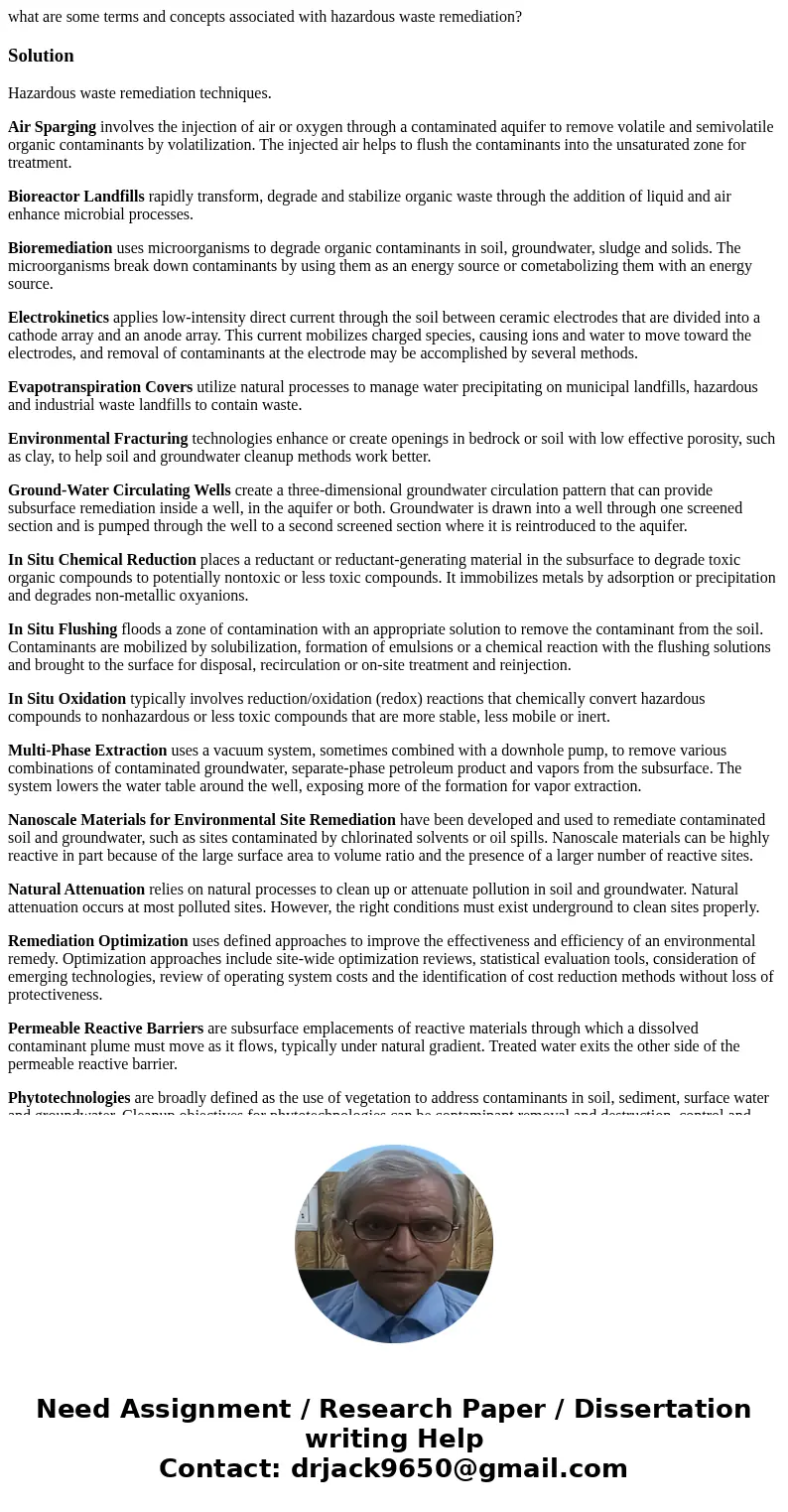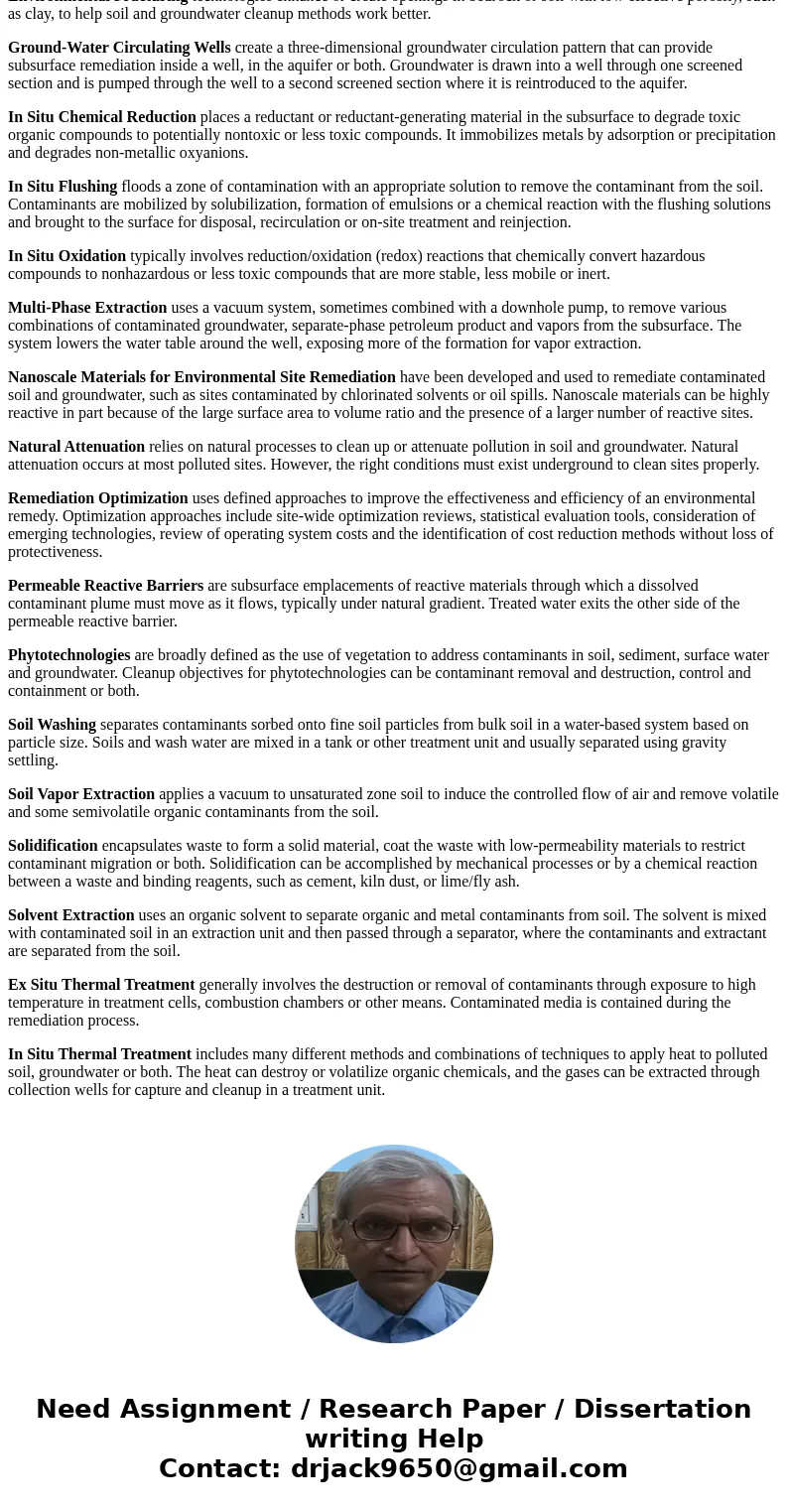what are some terms and concepts associated with hazardous w
what are some terms and concepts associated with hazardous waste remediation?
Solution
Hazardous waste remediation techniques.
Air Sparging involves the injection of air or oxygen through a contaminated aquifer to remove volatile and semivolatile organic contaminants by volatilization. The injected air helps to flush the contaminants into the unsaturated zone for treatment.
Bioreactor Landfills rapidly transform, degrade and stabilize organic waste through the addition of liquid and air enhance microbial processes.
Bioremediation uses microorganisms to degrade organic contaminants in soil, groundwater, sludge and solids. The microorganisms break down contaminants by using them as an energy source or cometabolizing them with an energy source.
Electrokinetics applies low-intensity direct current through the soil between ceramic electrodes that are divided into a cathode array and an anode array. This current mobilizes charged species, causing ions and water to move toward the electrodes, and removal of contaminants at the electrode may be accomplished by several methods.
Evapotranspiration Covers utilize natural processes to manage water precipitating on municipal landfills, hazardous and industrial waste landfills to contain waste.
Environmental Fracturing technologies enhance or create openings in bedrock or soil with low effective porosity, such as clay, to help soil and groundwater cleanup methods work better.
Ground-Water Circulating Wells create a three-dimensional groundwater circulation pattern that can provide subsurface remediation inside a well, in the aquifer or both. Groundwater is drawn into a well through one screened section and is pumped through the well to a second screened section where it is reintroduced to the aquifer.
In Situ Chemical Reduction places a reductant or reductant-generating material in the subsurface to degrade toxic organic compounds to potentially nontoxic or less toxic compounds. It immobilizes metals by adsorption or precipitation and degrades non-metallic oxyanions.
In Situ Flushing floods a zone of contamination with an appropriate solution to remove the contaminant from the soil. Contaminants are mobilized by solubilization, formation of emulsions or a chemical reaction with the flushing solutions and brought to the surface for disposal, recirculation or on-site treatment and reinjection.
In Situ Oxidation typically involves reduction/oxidation (redox) reactions that chemically convert hazardous compounds to nonhazardous or less toxic compounds that are more stable, less mobile or inert.
Multi-Phase Extraction uses a vacuum system, sometimes combined with a downhole pump, to remove various combinations of contaminated groundwater, separate-phase petroleum product and vapors from the subsurface. The system lowers the water table around the well, exposing more of the formation for vapor extraction.
Nanoscale Materials for Environmental Site Remediation have been developed and used to remediate contaminated soil and groundwater, such as sites contaminated by chlorinated solvents or oil spills. Nanoscale materials can be highly reactive in part because of the large surface area to volume ratio and the presence of a larger number of reactive sites.
Natural Attenuation relies on natural processes to clean up or attenuate pollution in soil and groundwater. Natural attenuation occurs at most polluted sites. However, the right conditions must exist underground to clean sites properly.
Remediation Optimization uses defined approaches to improve the effectiveness and efficiency of an environmental remedy. Optimization approaches include site-wide optimization reviews, statistical evaluation tools, consideration of emerging technologies, review of operating system costs and the identification of cost reduction methods without loss of protectiveness.
Permeable Reactive Barriers are subsurface emplacements of reactive materials through which a dissolved contaminant plume must move as it flows, typically under natural gradient. Treated water exits the other side of the permeable reactive barrier.
Phytotechnologies are broadly defined as the use of vegetation to address contaminants in soil, sediment, surface water and groundwater. Cleanup objectives for phytotechnologies can be contaminant removal and destruction, control and containment or both.
Soil Washing separates contaminants sorbed onto fine soil particles from bulk soil in a water-based system based on particle size. Soils and wash water are mixed in a tank or other treatment unit and usually separated using gravity settling.
Soil Vapor Extraction applies a vacuum to unsaturated zone soil to induce the controlled flow of air and remove volatile and some semivolatile organic contaminants from the soil.
Solidification encapsulates waste to form a solid material, coat the waste with low-permeability materials to restrict contaminant migration or both. Solidification can be accomplished by mechanical processes or by a chemical reaction between a waste and binding reagents, such as cement, kiln dust, or lime/fly ash.
Solvent Extraction uses an organic solvent to separate organic and metal contaminants from soil. The solvent is mixed with contaminated soil in an extraction unit and then passed through a separator, where the contaminants and extractant are separated from the soil.
Ex Situ Thermal Treatment generally involves the destruction or removal of contaminants through exposure to high temperature in treatment cells, combustion chambers or other means. Contaminated media is contained during the remediation process.
In Situ Thermal Treatment includes many different methods and combinations of techniques to apply heat to polluted soil, groundwater or both. The heat can destroy or volatilize organic chemicals, and the gases can be extracted through collection wells for capture and cleanup in a treatment unit.


 Homework Sourse
Homework Sourse